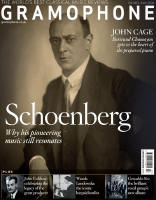Texte paru dans: / Appeared in:
|
|
|
|
|
|
Benjamin Alard’s project to record Bach’s complete harpsichord and organ music is laudable and ambitious, of interest in particular for the way he has programmed it not simply by grouping together genres or BWV numbers but by looking for musical and biographical connections across the great man’s output (and sometimes among other composers’ works too). Vol 9 is entitled ‘Köthen 1717-1723 – The Happy Years’, reflecting the fact that this was when, as Kapellmeister to the Prince of Anhalt-Cöthen, Bach for once had no church authorities in his hair but instead a music-loving patron and a high-class team of instrumentalists recently released from Frederick I’s court band in Berlin.
That image of him revelling in his working environment comes across most vividly in the Fifth Brandenburg, the world’s first-ever keyboard concerto, which, even if it was probably written before Cöthen, certainly had its spiritual home there. Alard invites an ad hoc ensemble to join him for a congenial performance with one-to-a-part nuance and detail, but in which the harpsichord’s presence is surprisingly reticent, especially as Alard has called into service the giant three-manual 1740 harpsichord by Hieronymus Albrecht Hass, once owned by Rafael Puyana but now living in the Musée Instrumental de Provins.
It is here perhaps, where the recordings were made, that technical problems have lain in wait, for both this concerto and the album’s other ensemble piece, the Italian cantata with written-out harpsichord part Amore traditore (ably sung by Marc Mauillon), suffer balances of such boxed-in dryness that any intrinsic qualities are difficult to enjoy. At times they sound like recordings made in a college practice room.
The harpsichord comes into its own more in the solo pieces, especially the Chromatic Fantasia and Fugue, whose organistic grandeur suits the power and colour range of its five sets of strings; Alard manages the fugue in particular very well, creating an impressive dynamic build-up towards the end. But while it makes sense to put such versatile registration to use in the concerto-like preludes to the Third and Fifth English Suites, the dance movements do not always respond so well, as even in lighter configurations the Hass is not an instrument that sings easily. The imitative counterpoint in the gigues gains delineation at first, but by the time the 16ft stop is out towards the ends they have become an indistinct wall of sound. There are other oddities to be heard in these recordings, too, from clipped endings to intrusive page turns (sometimes even over final chords), while the busy momentum of Alard’s playing itself can sometimes seem rather relentless.
This grand cycle is stimulating for the original thinking that lies behind its organisation and realisation, but for the pieces on this volume there are numerous better choices to make. And if you really want all your Bach played by one person, then Ton Koopman or Masaaki Suzuki (ongoing) still look like very reliable companions. |
|




